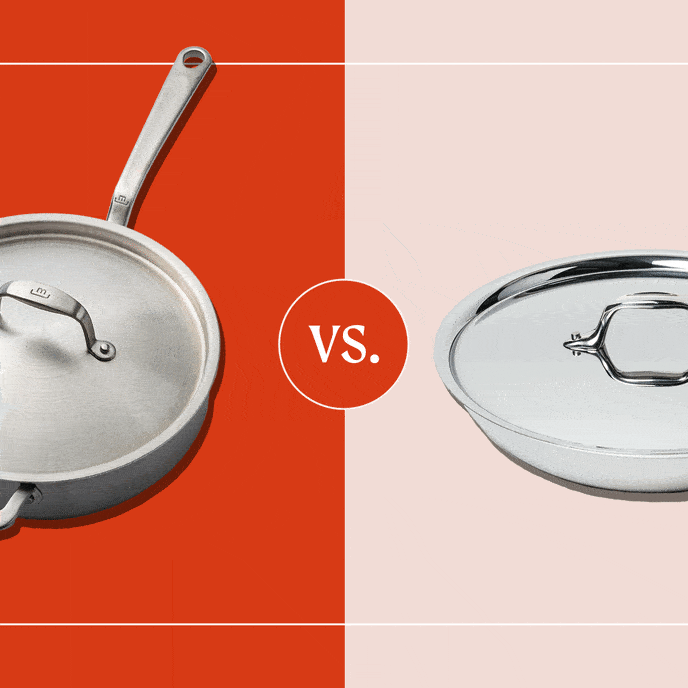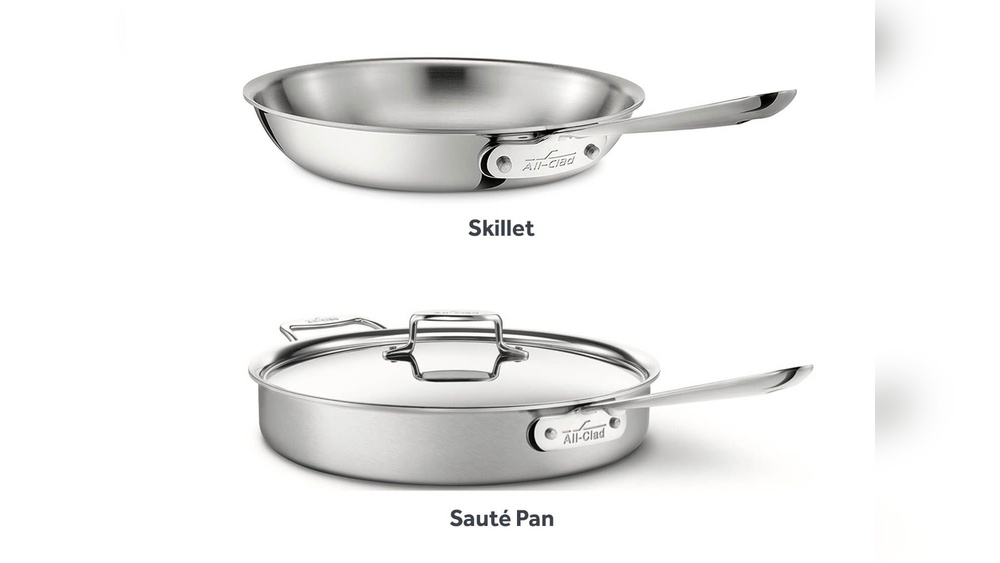When you’re in the kitchen, choosing the right pan can make all the difference in your cooking. You might wonder: what’s the real difference between a sauté pan and a frying pan?
Both look similar, but each one has unique features that can change how your food turns out. Understanding these differences will help you cook smarter, save time, and get better results with your favorite recipes. Keep reading, and you’ll discover exactly when to reach for your sauté pan and when a frying pan is your best friend.
This simple knowledge can transform your cooking experience—are you ready to level up?
Design Differences
The design differences between a sauté pan and a frying pan affect how you cook with each. These differences shape the cooking experience and the results you get. Understanding these design elements helps you choose the right pan for your recipe.
Shape And Side Profile
A sauté pan has straight, tall sides. These sides help hold liquids and prevent splashes. This makes it great for cooking with sauces or shallow frying. The frying pan has sloped, lower sides. These sides make flipping and tossing food easier. The wide opening helps moisture escape, ideal for frying or browning.
Material And Weight
Sauté pans are often heavier with thick bases. This weight helps distribute heat evenly for delicate cooking. Many sauté pans use stainless steel or anodized aluminum. Frying pans tend to be lighter with thinner walls. They heat up quickly and cool down fast. Materials include cast iron, aluminum, or non-stick coatings. The weight difference affects how the pans feel during cooking.

Credit: www.americastestkitchen.com
Cooking Techniques
Cooking techniques vary depending on the pan used. Sauté pans and frying pans differ in shape and design. These differences affect how you cook food. Understanding these techniques helps improve your cooking results. Here, we explore three key cooking methods using these pans.
Searing And Browning
Searing means cooking food quickly at high heat. It creates a brown, flavorful crust on meat or vegetables. A sauté pan’s flat bottom and straight sides hold heat well. This helps in even searing without losing moisture. Frying pans with sloped sides allow easier flipping but may lose heat faster. Both pans work, but sauté pans keep juices better during browning.
Shallow Frying
Shallow frying uses a small amount of oil to cook food. A sauté pan’s high sides prevent oil from splashing out. It holds the oil well around the food for even cooking. Frying pans have lower sides, which makes turning food easier. However, oil splashes more and can cause mess. For shallow frying, sauté pans offer better control and safety.
Sauce Preparation
Sauté pans excel in sauce preparation. Their straight, high sides keep liquids from spilling during stirring. This helps when adding broth, wine, or cream to cooked food. Frying pans may let sauces spill while mixing or simmering. Sauté pans allow easy reduction and thickening of sauces on the stovetop. They combine frying and sauce making in one pan efficiently.
Advantages Of Saute Pans
Saute pans offer several advantages that make them essential in many kitchens. Their unique design helps cook food evenly while keeping liquids and flavors inside. These features create better dishes and save time during cooking.
Retaining Liquids
Saute pans have tall, straight sides that hold liquids well. This design stops sauces and juices from spilling out. It allows cooking with liquids like wine or broth without losing flavor. It is perfect for simmering and making pan sauces.
High-heat Cooking
Many saute pans are made from materials like stainless steel. These materials handle high heat without warping. High heat helps sear meat and vegetables, locking in moisture and taste. Saute pans spread heat evenly, preventing hot spots and burning.
Versatility In Recipes
Saute pans work well for many cooking methods. They are great for searing, sautéing, frying, and braising. Their shape allows easy stirring and turning of food. You can cook a wide range of dishes with just one pan.

Credit: proware-kitchen.co.uk
Advantages Of Frying Pans
Frying pans offer several practical benefits that make cooking easier and faster. Their design focuses on simplicity and efficiency. They suit a wide range of everyday cooking tasks. Understanding these advantages helps in choosing the right pan for your kitchen.
Easy Flipping And Tossing
Frying pans have sloped sides that make flipping food simple. You can toss ingredients without much effort. This feature helps cook food evenly on all sides. It is perfect for stir-fries, pancakes, and omelets. The shape reduces the chance of food falling out.
Lightweight Handling
Most frying pans are lighter than sauté pans. This makes them easier to lift and move around the stove. Lightweight pans reduce strain during cooking. They are ideal for quick tasks that require frequent stirring. Handling becomes comfortable, especially for beginners or people with less strength.
Quick Cooking Tasks
Frying pans heat up quickly due to their thin, flat base. They are great for searing, frying, and browning food fast. Their wide surface allows better heat distribution. This speeds up cooking and saves energy. Meals can be prepared in less time without sacrificing taste.
When To Choose Each Pan
Choosing the right pan affects cooking results and ease. Both sauté pans and frying pans have unique features. Knowing when to use each helps prepare meals better. The shape and design of each pan suit different cooking styles. Understanding these differences guides your choice for every dish.
Best Uses For Saute Pan
Saute pans have tall, straight sides and a wide flat bottom. They hold liquids well without splashing. Use them for searing meat to get a nice brown crust. They work great for shallow frying with moderate oil. Saucy dishes fit perfectly as the sides keep sauces inside. The pan’s high heat retention helps cook food evenly. Braising vegetables or meats is easy in a sauté pan. Stirring and tossing food is simple without spilling. It also suits recipes needing quick liquid reduction.
Best Uses For Frying Pan
Frying pans feature low, sloped sides for easy flipping. They allow steam to escape quickly, keeping food crispy. Ideal for frying eggs, pancakes, or stir-frying vegetables. The sloped sides help turn food without breaking it. They heat up fast, perfect for quick cooking tasks. Frying pans are light and easy to handle. Great for sautéing small amounts of food. They work well for cooking foods needing fast, direct heat. Use them for browning, frying, and simple sautéing.

Credit: deliciouslyrushed.com
Substituting One For The Other
Choosing between a sauté pan and a frying pan can be tricky in the kitchen. Both pans have unique shapes and uses. Sometimes, you might want to use one pan instead of the other. Understanding how to substitute a sauté pan for a frying pan, or vice versa, helps in cooking different recipes.
Possible Scenarios
A sauté pan works well when you need to cook food evenly without spilling. Its high, straight sides hold liquids and keep oil contained. You can use it for shallow frying, searing meat, or making sauces.
A frying pan has sloped sides that make flipping and tossing food easier. It is best for frying eggs, pancakes, or stir-frying vegetables. If you do not have a frying pan, a sauté pan can often take its place.
For example, when frying chicken or fish, a sauté pan helps keep oil inside. When cooking dishes that need quick stirring or flipping, a frying pan is better. Sometimes, recipes that call for one pan type can be done with the other by adjusting your technique.
Limitations And Considerations
Using a sauté pan instead of a frying pan may slow down cooking. The straight sides can make stirring or flipping food harder. This can cause uneven cooking in some recipes.
A frying pan may not hold liquids well during cooking. If the recipe needs to keep sauces or juices, the frying pan can cause spills. This is because of its low, sloped sides.
Heat distribution also differs. Some sauté pans are heavier and hold heat longer. Frying pans heat quickly but may lose heat when adding cold food. Consider these points before substituting one pan for the other.
Material Considerations
Material plays a key role in the performance of sauté pans and frying pans. The choice of material affects heat distribution, durability, and cooking ease. Different materials also impact how food cooks and how easy the pan is to clean. Understanding these material options helps you pick the right pan for your kitchen tasks.
Stainless Steel Options
Stainless steel pans are strong and resistant to rust and stains. They heat evenly but may need oil to prevent sticking. These pans handle high heat well, perfect for searing and browning. Stainless steel sauté pans often have a thick base to spread heat across the pan. Frying pans made of stainless steel offer durability and a classic look. They work well for tasks needing steady heat and quick temperature changes.
Nonstick Surfaces
Nonstick pans have a coating that stops food from sticking. They require less oil, making cooking healthier. Nonstick frying pans are ideal for eggs, pancakes, and delicate foods. Sauté pans with nonstick surfaces help cook food gently without burning. However, nonstick coatings can wear off over time and need careful use with metal utensils. These pans heat quickly but may not be suitable for very high temperatures.
Frequently Asked Questions
Can A Sauté Pan Be Used For Frying?
Yes, a sauté pan works well for frying, especially shallow frying and searing. Its high sides prevent oil splashes.
Is A Sauté Pan Better Than A Frying Pan?
A sauté pan has straight, high sides ideal for searing and sauces. A frying pan’s sloped sides ease flipping. Choose based on cooking style and ease of handling.
What Are The Disadvantages Of A Sauté Pan?
Sauté pans have high, straight sides that can make flipping food difficult. They tend to be heavier and less maneuverable than frying pans. Their design may not suit quick, light cooking tasks, and they can take longer to heat evenly compared to pans with sloped sides.
When Would You Use A Sauté Pan?
Use a sauté pan for searing, browning, shallow frying, and making pan sauces. Its high, straight sides hold liquids and prevent splashes. It handles high heat well, ideal for cooking with oil and sauces.
Conclusion
Choosing between a sauté pan and a frying pan depends on your cooking needs. A sauté pan’s high, straight sides hold liquids and oil well. It suits searing, shallow frying, and making sauces. A frying pan’s sloped sides help flip and toss food easily.
It works best for eggs, omelets, and quick frying. Both pans have unique strengths. Using the right pan improves cooking results and kitchen comfort. Keep these differences in mind to cook smarter and enjoy your meals more.

